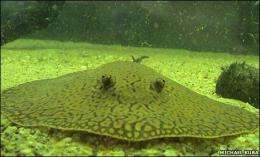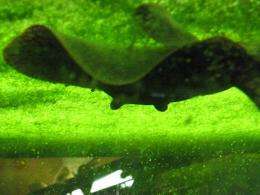January 18, 2010 weblog
Stingrays Are Cute, And Pretty Smart Too! (w/ Video)

(PhysOrg.com) -- A gift from the Parc Merveilleux Zoo in Luxembourg to the Tiergarten Schonbrunn Zoo in Vienna made in 2003 led to a serendipitous research project by zoo observers.
The gift: several adult South American Vermiculate river stingrays (Potamotrygon castexi). The research: designing a way to test the cognitive abilities of the stingrays.
Shortly after the adult stingrays were delivered to the Vienna Zoo, one of the females gave birth to six stings. The stings were separated from the adults and kept in an 850 liter aquarium covered with layers of duckweed to reduce the ambient light from the room.
The plants became very dense, and soon the young stingrays were observed floating on their backs inspecting them. Then, the stings began to spurt water from the tank through the duckweed, all over the floor. Even after a layer of mesh was placed on the tank to limit the mess, the stingrays perfected their aim, and spit water right through the tiny holes in the mesh.

What was all this about? Was it a form of stingray play? An effort to get human attention?
Dr. Michael J. Kuba, leader of the stingray project reported: "My interpretation is that small food remnants remained lodged in the duckweed, triggering the "water spouting" behavior. Also, the rays appeared to have learned that humans mean "food" and, therefore, began to spout water as soon as someone approached the aquarium."
Three researchers, including Dr. Kuba and Ruth A. Byrne - both of whom recently worked at the Konrad Lorenz Institute for Evolution and Cognition Research (Altenberg, Austria), now at the Hebrew University in Jerusalem - and Gordon M. Burghardt, Professor at the University of Tennessee, USA, developed a method for studying problem solving and tool use in stingrays.
Five of the stings were studied. Each one faced a food-filled plastic pipe with one end sealed (black) and the other open (white). The challenge for each was to figure out how to get the food out of the pipe.
All of them figured out how to get the food quickly, one on the first attempt. They were able to differentiate the white end of the tube on repeated tries, and they all used water as a tool to help get their food out of the pipe. (They squirted water into the tube to loosen the food and then sucked the food out of the pipe.)
This level of cognitive ability - both the ability to use tools and the ability to problem solve - has never been revealed before about the stingray. Neither, according to Dr. Kuba, have stingrays been studied cognitively before. "...like sharks, [stingrays] have often been considered to be reflex machines having very acute senses but limited cognitive capacities," he told BBC's EarthNews.
Finding out more about cognition in stingrays could tell us more about the evolution of cognition in other vertebrates. But can they have their own act at Sea World?
That, we shall see.
More information:
-- BBC Earth News (news.bbc.co.uk/earth/hi/earth_ … _8452000/8452008.stm)
-- Animal Cognition (www.springerlink.com/content/v566g42110144620/)
-- Vienna Zoo (www.zoovienna.at/e/rochen.html)
© 2010 PhysOrg.com
















